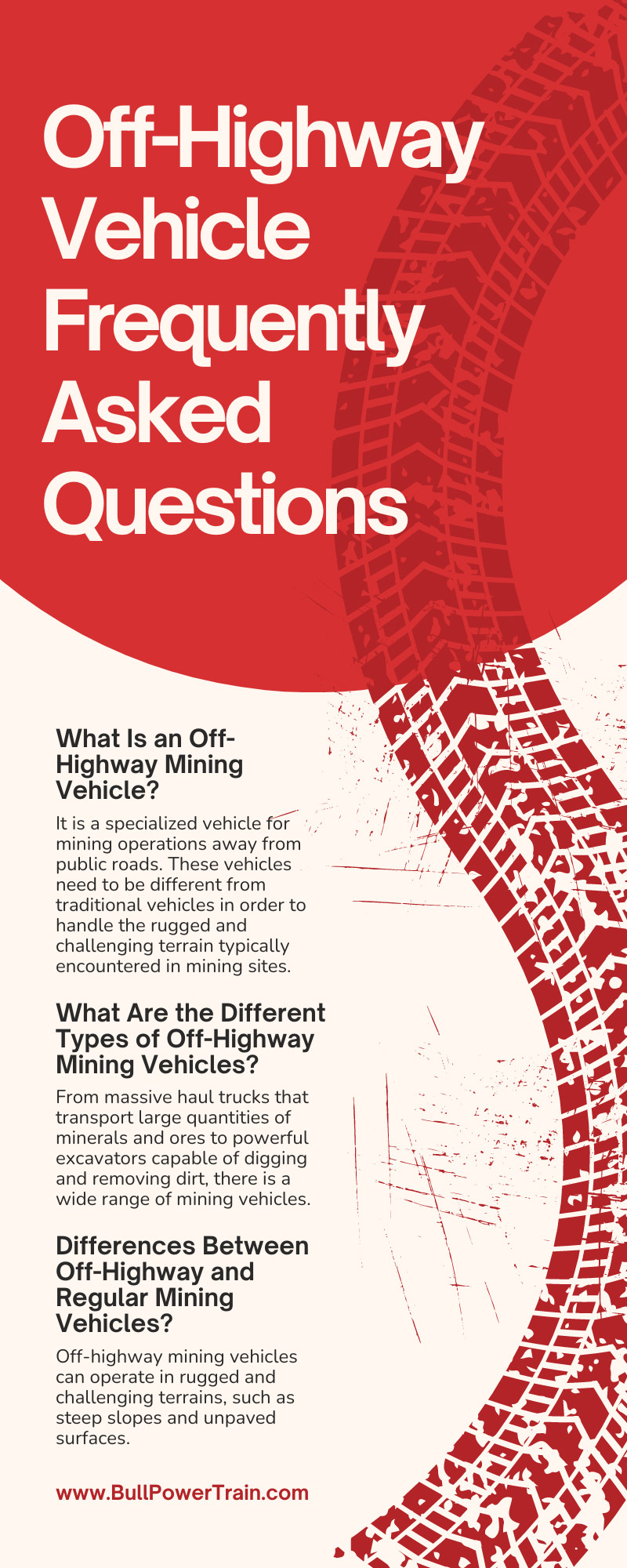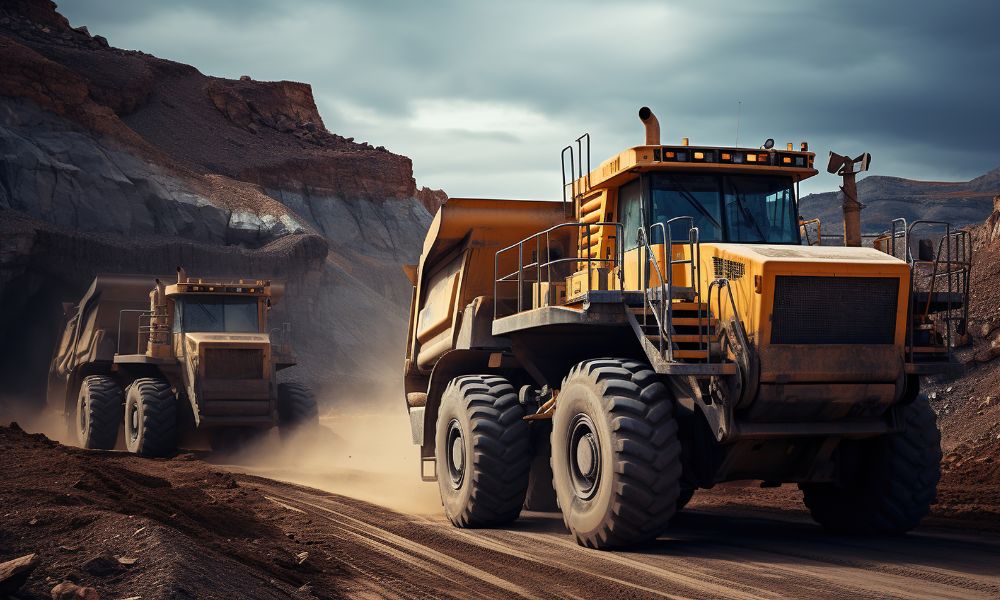The equipment that businesses use in off-highway mining operations is incredibly important, and there’s no one-size-fits-all piece of equipment or vehicle that works for every mining project. Whether you’re a seasoned professional seeking advanced insights or someone new to the field of mining, it’s important to understand the most common off-highway vehicle questions. With these questions and answers, you can better grasp the complexity of these mining machines and how you can responsibly take care of them.
What Is an Off-Highway Mining Vehicle?
An off-highway mining vehicle, also known as an off-road mining vehicle, is a specialized vehicle for mining operations away from public roads. These vehicles need to be different from traditional vehicles in order to handle the rugged and challenging terrain typically encountered in mining sites. The primary function of off-highway mining vehicles, thanks to their engines and hauling capabilities, is transporting heavy loads of minerals or materials.
Additionally, these vehicles often come with specialized features such as hydraulic systems for dumping loads, reinforced tires for enhanced durability, and advanced suspension systems for maneuverability in rough terrains. Overall, off-highway mining vehicles play a crucial role in the mining industry by facilitating the transportation of valuable resources.
What Are the Different Types of Off-Highway Mining Vehicles?
From massive haul trucks that transport large quantities of minerals and ores to powerful excavators capable of digging and removing dirt, there is a wide range of mining vehicles. Additionally, there are drilling rigs capable of exploration and extraction, as well as bulldozers and graders for land preparation and maintenance. Each type of vehicle plays a crucial role in optimizing mining efficiency and productivity, ensuring smooth operations in this demanding industry.
What Are the Differences Between Off-Highway and Regular Mining Vehicles?
Off-highway mining vehicles differ from regular mining vehicles in several ways. Firstly, off-highway mining vehicles can operate in rugged and challenging terrains, such as steep slopes and unpaved surfaces. Their powerful engines and robust suspensions allow them to navigate through these demanding environments.
Additionally, off-highway mining vehicles have significantly larger capacities compared to regular mining vehicles. This enhanced capacity allows them to transport larger quantities of materials, such as ore or overburden, in a single haul. These vehicles often feature specialized dumping mechanisms to efficiently unload their cargo at designated locations as well. Off-highway mining vehicles also have advanced safety features, such as roll-over protection systems, to keep operators safe.
Which Factors Are Most Important?
When selecting an off-highway mining vehicle, you should consider a few crucial factors, including:
- Vehicle power
- Torque capabilities
- Payload capacity
- Fuel efficiency
- Maneuverability
- Maintenance requirements
- Safety features
Additionally, the type of terrain and operating conditions also ensure that the vehicle is suitable for the specific mining environment you have in mind. By carefully evaluating these factors, mining operators can make informed decisions and choose the most suitable off-highway mining vehicle for their operations.
What Makes These Off-Highway Systems Efficient?
From the engine and transmission to the durable chassis and suspension, each element helps the vehicle navigate challenging terrains, withstand heavy loads, and optimize productivity during mining. By integrating cutting-edge technology and features such as advanced braking systems and intelligent control systems, these vehicles enhance safety, fuel efficiency, and overall performance in the mining industry.
Can You Customize These Vehicles?
Customization offers a range of benefits, including improved efficiency, optimized performance, and enhanced safety. By tailoring these vehicles to the unique requirements of your mining operation, companies can maximize productivity, minimize downtime, and thrive in challenging environments. Whether it’s adapting to different terrains, incorporating specialized equipment, or enhancing operator comfort, customization plays a crucial role in meeting the diverse needs of mining operations.
What Does Maintenance Look Like?
When it comes to properly maintaining and servicing off-highway mining vehicles, there are several effective best practices that can ensure their longevity and performance. One key aspect is implementing a comprehensive maintenance strategy that includes regular inspections, preventive maintenance tasks, and timely repairs. By staying on top of maintenance schedules and addressing issues promptly, operators can prevent small problems from escalating into major breakdowns.
Additionally, adhering to industry standards and guidelines is crucial for maintaining the optimal performance of off-highway mining vehicles. Typically, the manufacturer will make recommendations regarding changes, maintenance intervals, lubrication, and component replacements for operators to follow. Furthermore, operators should ensure that all maintenance personnel have the training, knowledge, and tools required to perform tasks effectively and safely.
What Is the Lifespan of Off-Highway Mining Vehicles?
On average, the operational lifespan of an off-highway mining vehicle can vary depending on several factors. These factors include the type of vehicle, maintenance practices, operating conditions, and the specific mining project demands. Generally, with proper maintenance and regular servicing, these vehicles can remain operational for years.
However, harsh operating conditions, such as extreme temperatures and heavy loads, can potentially shorten their lifespan. It is crucial for mining companies to implement effective maintenance strategies and ensure optimal operating conditions to maximize the longevity of these valuable assets. Maintenance is important in every industry, but it’s especially vital for off-highway mining vehicles.
Are These Vehicles Cost-Effective?
When considering cost-effectiveness, it is important to evaluate the advantages of owning an off-highway mining vehicle versus outsourcing equipment for mining operations. By owning a mining vehicle, companies have the benefit of having direct control over their equipment, allowing for greater flexibility and customization.
Additionally, owning a vehicle can potentially lead to long-term cost savings, as it eliminates the need for recurring rental fees or outsourcing expenses. On the other hand, outsourcing equipment may provide a more immediate solution, especially for short-term or specialized projects. Carefully weighing these factors and considering the specific needs of your mining operation needs can help determine the most suitable approach for optimizing cost-effectiveness.
Are These Vehicles Safe?
When it comes to operating off-highway mining vehicles, it is crucial to prioritize safety at all times. Safety in this realm includes regular maintenance and inspections of the vehicles to ensure they remain in optimal condition. Additionally, operators need the right training to understand the specific risks associated with operating these vehicles and how to mitigate them effectively.
A significant aspect of mining vehicle safety revolves around the operators wearing the right personal protective equipment (PPE), but safety doesn’t stop here. To be safe, operators must also establish and follow clear communication protocols between themselves and other workers and supervisors. By implementing these safety measures and protocols, we can create a safer working environment for everyone involved in off-highway mining operations.
Hopefully, these answers to the most commonly asked off-highway vehicle questions provide you with the valuable and detailed information you need for your mining operation. Mining is not easy, and even with those vehicle questions and answers, it can be tricky. However, with the right people by your side, it can be easy. The team at Bull Powertrain has industrial knowledge, as well as the equipment you may need, including Clark powertrain components. We are here to support you and your mining operation every step of the way.


